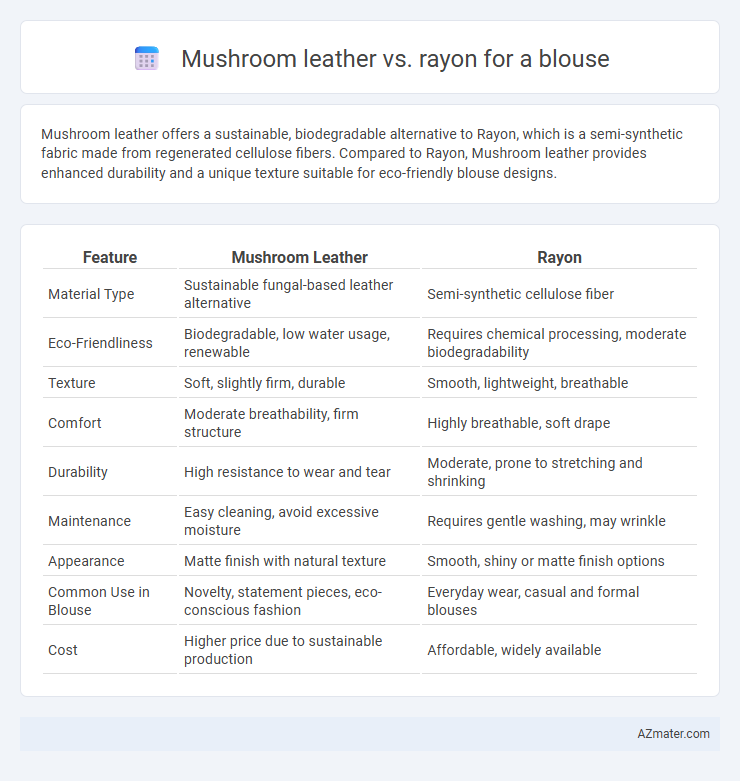Mushroom leather offers a sustainable, biodegradable alternative to Rayon, which is a semi-synthetic fabric made from regenerated cellulose fibers. Compared to Rayon, Mushroom leather provides enhanced durability and a unique texture suitable for eco-friendly blouse designs.
Table of Comparison
| Feature | Mushroom Leather | Rayon |
|---|---|---|
| Material Type | Sustainable fungal-based leather alternative | Semi-synthetic cellulose fiber |
| Eco-Friendliness | Biodegradable, low water usage, renewable | Requires chemical processing, moderate biodegradability |
| Texture | Soft, slightly firm, durable | Smooth, lightweight, breathable |
| Comfort | Moderate breathability, firm structure | Highly breathable, soft drape |
| Durability | High resistance to wear and tear | Moderate, prone to stretching and shrinking |
| Maintenance | Easy cleaning, avoid excessive moisture | Requires gentle washing, may wrinkle |
| Appearance | Matte finish with natural texture | Smooth, shiny or matte finish options |
| Common Use in Blouse | Novelty, statement pieces, eco-conscious fashion | Everyday wear, casual and formal blouses |
| Cost | Higher price due to sustainable production | Affordable, widely available |
Introduction to Sustainable Fabrics: Mushroom Leather and Rayon
Mushroom leather, made from mycelium, offers an eco-friendly alternative to traditional fabrics with its biodegradable and renewable properties, reducing environmental impact compared to synthetic options. Rayon, derived from regenerated cellulose fibers, combines natural sources like wood pulp with chemical processing, providing a versatile but less sustainable fabric due to its energy-intensive production. Choosing mushroom leather supports sustainable fashion initiatives by minimizing resource use and waste, while rayon remains popular for its softness and affordability despite environmental trade-offs.
What is Mushroom Leather?
Mushroom leather, also known as mycelium leather, is an innovative sustainable material derived from the root structure of fungi, offering a vegan alternative to traditional animal leather. Compared to rayon, which is a semi-synthetic fiber made from cellulose, mushroom leather provides unique durability and eco-friendliness with a biodegradable composition. Its breathable, flexible texture makes it an increasingly popular choice for blouses seeking a combination of ethical fashion and functional wear.
What is Rayon Fabric?
Rayon fabric, a semi-synthetic fiber made from regenerated cellulose, offers a lightweight, breathable, and smooth texture ideal for blouses. Compared to mushroom leather, rayon provides superior drape and softness, enhancing garment comfort and flow. Its moisture-absorbing properties make rayon a popular choice for warm weather clothing, though it lacks the durability and eco-friendliness of mushroom leather.
Environmental Impact: Mushroom Leather vs Rayon
Mushroom leather, derived from sustainable fungal mycelium, offers a biodegradable alternative to rayon, which is made from cellulose but often involves chemically intensive processing. The production of mushroom leather significantly reduces water usage and harmful chemical pollutants compared to rayon, which relies on toxic solvents like carbon disulfide in viscose manufacturing. Choosing mushroom leather for blouses supports lower carbon emissions and less environmental degradation, making it a more eco-friendly fabric option.
Production Process Comparison
Mushroom leather is produced using mycelium, the root structure of fungi, which grows rapidly in controlled environments with minimal water and no toxic chemicals, making it a sustainable alternative to synthetic fabrics. Rayon, derived from cellulose in wood pulp, undergoes a chemically intensive process involving treatments with sodium hydroxide and carbon disulfide, which can release hazardous pollutants during production. The mushroom leather process emphasizes eco-friendly cultivation and biodegradability, whereas rayon manufacturing relies heavily on industrial chemical extraction and regeneration techniques.
Durability and Longevity of Mushroom Leather and Rayon
Mushroom leather offers superior durability and longevity for blouses compared to rayon, resisting tearing and maintaining its structure over time even with frequent wear. Rayon, a semi-synthetic fiber, tends to weaken with repeated washing and exposure to sunlight, leading to faster wear and color fading. The natural, robust fibers in mushroom leather ensure a longer lifespan, making it a more sustainable and resilient choice for blouse fabric.
Comfort and Wearability: Blouse Performance
Mushroom leather offers superior breathability and moisture-wicking properties compared to rayon, enhancing overall comfort during prolonged wear. Its natural elasticity and durability allow for better shape retention and resistance to wear, contributing to a longer lifespan and consistent blouse performance. Rayon, while lightweight and smooth, tends to retain moisture and can lose structure over time, reducing comfort and wearability in blouses.
Style Versatility and Aesthetics
Mushroom leather offers a unique, eco-friendly texture with a natural matte finish that enhances blouse design through sustainable fashion aesthetics. Rayon provides a smooth, flowing drape with vibrant color absorption, ideal for versatile, elegant blouse styles suitable for both casual and formal occasions. Choosing mushroom leather emphasizes innovative, eco-conscious fashion statements, while rayon prioritizes comfort and a dynamic range of visual appeal.
Cost Analysis: Mushroom Leather Blouses vs Rayon
Mushroom leather blouses typically incur higher production costs due to sustainable sourcing and innovative processing techniques, resulting in a price premium compared to rayon blouses. Rayon is more cost-effective, benefiting from large-scale manufacturing and widespread availability, making it an economical choice for budget-conscious consumers. When evaluating cost analysis, mushroom leather offers eco-friendly durability but at a significantly higher price point than the affordable and versatile rayon fabric.
Which is Better for Blouses: Mushroom Leather or Rayon?
Mushroom leather offers superior breathability, natural antibacterial properties, and sustainability compared to rayon, making it an innovative choice for blouses that prioritize eco-friendliness and comfort. Rayon, made from cellulose fibers, provides a lightweight, soft texture with excellent drape, ideal for flowy blouse designs but may lack durability and moisture-wicking abilities seen in mushroom leather. When choosing the better fabric for blouses, mushroom leather excels in durability and environmental impact, while rayon remains favored for affordability and a silky feel.

Infographic: Mushroom leather vs Rayon for Blouse
 azmater.com
azmater.com